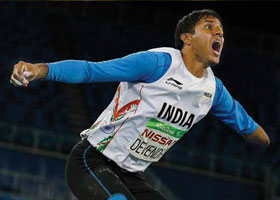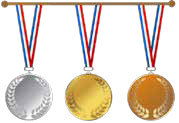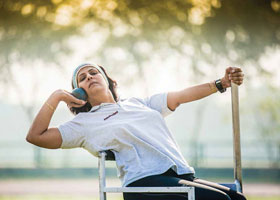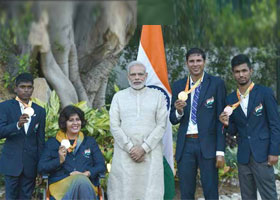
Four Paralympic athletes made India proud, winning medals at the Rio 2016 Paralympic Games. They overcame many odds to make their mark in the field of sports. The medal winners have now been honoured with Khel Ratna awards
It is not just the four medal winners at the Rio 2016 Paralympics for whom life has changed, but the entire community of para athletes of the country. Besides money which has been pouring in, the Khel Ratna Awards have come as a morale booster for these athletes.
But there is a dark side to the story, in that many brands are still fighting shy of offering whole-hearted support to these high-achieving athletes.
The Khel Ratna awards are given to outstanding sportsmen/sportswomen of the country. “Yes, it is a big leap for these athletes who have been forgotten heroes of the country,” said one of the followers of these athletes, and what is more ironic is the fact that these athletes have won more medals at these games than the able athletes at the same level of championship in the globe.
“Yes, they are also deserving candidates for the Khel Ratna Awards,” announced Vijay Goel, Minister of State (Independent Charge) Ministry of Youth Affairs And Sports at a function to felicitate the four Paralympic athletes after they arrived in the country with their prize procession of medals.
“Going by the count, the country has garnered equal number of medals in the last four editions of the Games (2004-2016), but the Paralympic athletes have won two gold while able bodied athletes have just one gold under their belt.”
A look back on the four medal winners at the Rio 2016 Paralympic Games:

It was the high jumper Mariyappan Thangavelu who set the ball rolling for the Indian athletes. The 21-year-old Tamil Nadu athlete won the T42 class for athletes with lower limb impairment. Mariyappan grew up in extreme poverty in the southern state of Tamil Nadu, where he lives with his mother and two siblings in a house that is smaller than his room in the athletes' village. Mariyappan was a child when an accident left him with a permanent impairment. A state bus swerved off the road and ran over him, shattering his right leg below the knee. His mother had to take a loan for his medical treatment. Sports was a constant passion for Mariyappan. He played volleyball in school before one of the school teachers suggested high jump when he was 14. And it was here that a new champion rose on the blocks, as he finished second in a competition against able-bodied competitors. Like at home, the modest and determined Thangavelu won the support of the crowd at the Olympic stadium. As the bar was raised and his opponents got eliminated one by one, the excitable Brazilian fans began to throw their support behind the 1.68-metre tall Indian. He was the only athlete to clear 1.89 metres. Mariyappan uses his right leg and damaged right foot in particular to propel the beginning of his approach and then power his launch over the bar. He says his right toe gives him leverage.

Deepa Malik celebrated her 46th birthday on September 30. One of the oldest athletes, Deepa won silver in the shot put (shot put - F53) event. Born in Bhaiswal, Sonipat district, Haryana, Deepa is a resident of Delhi where she stays with her husband Malik, a veteran cavalier, Colonel Bikram Singh. She is also the daughter of a veteran Infantry, Colonel BK Nagpal. She is the mother of two adult daughters, Devika and Ambika. She is currently being supported by the GoSports Foundation through their Para Champions Programme. Deepa is associated with the Himalayan Motorsports Association (H.M.A.) and the Federation of Motor Sports Clubs of India (F.M.S.C.I.). She has undertaken an eight-day, 1700-km drive in sub-zero temperatures which included a climb of 18000 feet, at the Raid De Himalaya. She is a member of the working group formulating the 12th Five-Year plan (2012-2017) on Sports and Physical Education, nominated by the Planning Commission HRD Division on behalf of the Sports Ministry. The Rio Olympics bronze medallist wrestler Sakshi Malik termed the life story of para athlete Deepa Malik as inspiring. “Deepa Malik narrated her life story to me. Her story is very inspiring. Indeed, I learned a lot from her," said Sakshi. Deepa overcame a spinal tumour, 31 surgeries and 183 stitches to win India a silver medal at the Rio Paralympics. Life has never been able to pose a challenge that could dim Deepa’s spirit. From getting operated upon when her husband was serving the nation in Kargil and getting 183 stitches between her shoulder blades, she has been a real-life inspiration for years now. Having won sporting laurels at the international stage for close to a decade, the only medal missing from her repertoire was the Paralympic one. And at Rio, she fulfilled even this dream. She has never been daunted by adversity. When told as a 26-year-old that her choice was between paralysis and death, anyone else would have had a meltdown. A budding sportswoman and cricketer for Rajasthan despite suffering paralytic shocks since the age of eight, Deepa, however, faced the impossibility of life head-on. Seven broken vertebrae and frequent MRI scans in the absence of titanium plates did not stop her.
The Khel Ratna awards, which are given to outstanding sportspersons of the country, is a big leap for these athletes who have been forgotten heroes of the country

Devendra Jhajharia, hauled the javelin to a distance of 63.97 metres at the Rio Paralympic games -- a world record incidentally bettering his own mark set at the 2004 Summer Paralym pics at Athens, to snatch the second gold medal for the country competing in the F46 event. The first Indian Paralympian to win two gold medals at the Paralympics, he won his first gold in the javelin throw at the 2004 Summer Paralympics. Devendra already has a long list of achievements to his name. He was born into a low-income family in the Churu district in Rajasthan. At the age of eight, he lost his left hand after accidentally touching an electric wire while trying to climb a tree. However, Jhajharia’s life took a turn after he began participating in para-athletics in 1995 while in school. In 1997, coach Ripudaman Singh identified his potential when he saw him competing in a school tournament and encouraged him to take up the sport seriously. India’s flag-bearer at the 2016 Paralympics, Devendra is a recipient of the Arjuna award in 2005. The same year, Rajasthan government also felicitated him with the Maharana Pratap Puraskar Award.
The country has garnered equal number of medals in the last four editions of the Games (2004-16), but the paralympics have won two gold while able bodied athletes have just one gold
Varun Singh Bhati, who competed alongside Mariyappan in the men's high jump T-42 event at the Games was a leader during the course of the final event. Although he could not maintain the lead, he made history along with Mariyappan and won the bronze for the country. Bhati jumped his personal best of 1.86 metres to finish third. The 21-year-old, who trains at the Sports Authority of India (SAI) centre in Bengaluru, is suffering from a disability classification in sports for differently-abled track-and-field athletes with a single ‘above the knee' amputation or a comparable disability. A resident of Greater Noida, he is the son of Hem Singh Bhati and also a student of BSc. Maths (Hons). Varun’s inherent talent was spotted by St Joseph’s School, Greater Noida from where he did his schooling and is still his home ground. His talent is further nurtured by Satyanarayana, a former national athlete. Varun is currently being supported by the GoSports Foundation through the Para Champions Programme. Varun managed to find the right balance in sports and education and made great progress in both. Afflicted by polio at a young age, Varun took to sports in his school days, and has been consistently getting better.

The different classifications are identified by letters. Thus, T is for track and jumping events, F is for field events, while the numbers specify the type and severity of disability. The lower the numbers, the more severe the impairment.
By Joe Williams